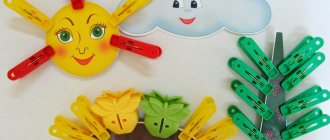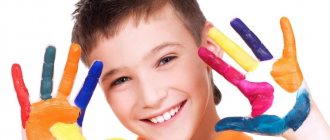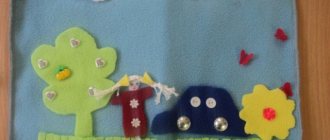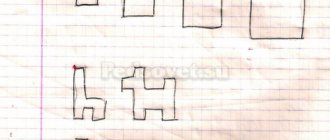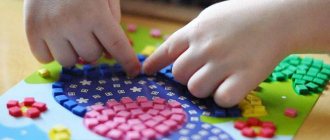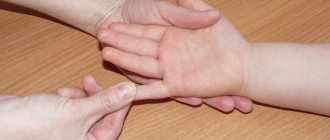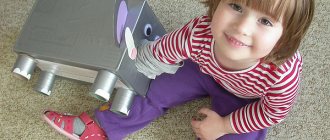Author: Nizamutdinova Gulsina Gabdulkadirovna
The sensorimotor development of a preschooler is the development of his perception and the formation of ideas about the external properties of objects: their shape, color, size, position in space and the development of the motor sphere. The importance of sensorimotor development in early and preschool childhood is difficult to overestimate. It is this age that is most favorable for improving the functioning of the senses and accumulating ideas about the world around us.
The basic principles of work on the development of fine motor skills correspond to the basic pedagogical principles: the developmental nature of training, systematicity and consistency, consciousness and activity in learning, clarity and taking into account age and individual characteristics. Game complexes are carried out with a subgroup of children (no more than 10 people) and require a wide variety of handouts in sufficient quantities. Our parents help us prepare it.
When selecting play exercises, the following principles should be taken into account: play exercises should bring joy to children, and personal relationships between an adult and a child are built on the basis of trust, mutual understanding, and goodwill. The child knows that he will receive the necessary help in case of difficulties; gradual complication of game material, exercises, from simple to complex.
The variety of materials used allows children to vary their activities from folding origami to dough plastic, from lacing to beading. To select speech material, it is good to use riddles, tongue twisters, physical education minutes, and short poems.
In the presentation I presented, you will see the most striking moments in working on the development of fine motor and sensory skills.
Systematic work in this direction allows us to achieve the following positive results: the brush acquires good mobility and flexibility, stiffness of movements disappears, pressure changes, which in the future helps children easily master the skill of writing, and artistic taste is formed
I would like to dwell on each age stage in more detail, so
1-2 years
The task of games-activities for the sensory development of children
The main task of games and activities for children is to accumulate a variety of sensory experiences, which would help to systematically accumulate knowledge, gain new ones, and apply them in different situations at the next stages of learning and fine art and design.
— What games do you use at home for sensory development?
— How do you play with your children?
— What do these games teach a child?
It is important that educators, when organizing games and activities, use brief verbal instructions and do not distract children from completing tasks with words.
But many studies in the field of correctional pedagogy show that children often have underdeveloped perception: it is fragmented, inaccurate and unfocused. Preschoolers have insufficiently developed sensory standards.
Therefore, there is a need to create conditions that would allow the exercise of sensory functions during systematic training. Children train to distinguish and classify signs of the world around them in order to more accurately and adequately interact with it.
The effectiveness of didactic games in the sensory development of preschool children
The main ways to influence sensory standards in preschoolers are exercises, didactic and objective games. This can be explained by the fact that younger preschoolers most of all need play activity.
In the process of didactic games, you can not only monitor the formation of the child’s skills and qualities, but also guide and correct them in the right direction.
Didactic games induce in children the ability to think independently and apply existing knowledge in different conditions in accordance with the assigned tasks. It should also be noted that exercises and games need to be carried out in a certain system in connection with the way children are raised and sensory trained.
Taking this into account, in order to develop sensory standards and increase the level of sensory development, we have developed a set of didactic games.
When working with sensory development, I consistently and systematically use exercises and didactic games. This is precisely the main means of sensory education. I try to introduce them into one form or another of the educational process.
First, I drew up a long-term plan for the formation of sensory standards. I tried to distribute the material in a sequence that provides for a gradual transition from easy to difficult.
For example, first children must become familiar with certain sensory properties - the shape and size of objects that are explored by touching. They are then able to perceive color using vision.
The principle of consistency is also applied in the fact that first children become familiar with properties that differ sharply from each other, and then those that have similar characteristics. Moreover, it is necessary to take into account the age of preschoolers and what stage of their development they are at.
When developing preschoolers’ ideas about different colors, you need to act in stages. First, preschoolers must learn to navigate contrasting colors and match similar objects to samples.
For this purpose, didactic games are organized in which children can put things on plates, find similar balls and show a similar mosaic. From the first lessons, it is important not only to name what color the objects are, but also to place some objects tightly against others.
At the next stage, children learn to develop the ability to navigate in contrasting colors: green and yellow, blue and red. To do this, they use tasks in which children select similar objects according to a sample.
There are various educational games for this purpose. Children tie strings to balls, put bouquets in vases, hide mice, arrange objects by color, and put butterflies on flowers. And if at first the children make mistakes, they are helped by showing them the correct pattern of actions.
To make it more interesting for children, you can use different teaching materials, trying to alternate them throughout the lesson.
At this stage, preschoolers usually develop an understanding that different objects can have the same color. Toys and natural materials that have the desired color are selected.
Children can complete the following tasks: “Find objects that are only blue or red.” To develop ideas about what shape objects have, you need to help children compare them.
For example, I can ask the question: “Tell me, guys, what shape is this ball?” And then I tell them: “This ball is round, like an orange.” Then I invite the children to find objects with a similar feature themselves.
At the same time, it is necessary to teach children to perform such practical actions as overlaying figures, turning them over and applying them. Children trace the outlines of the figures with their fingers and perform other actions.
When a child has completed a number of practical actions, it is easier for him to recognize the figures that he needs to know in early preschool age. To correctly determine the size of an object, preschoolers need to develop the ability to select objects with the same size as the sample.
Then the children are given tasks that would develop their ability to distinguish objects by their size, overlapping or applying them to each other.
This allows you to fix the names of subject properties. During games to determine quantities, you need to use as many objects as possible, which are prepared in advance. These can be toys of different sizes.
With the help of didactic games, you need to shape children's thinking and their attention. These processes are inextricably linked with the acquisition of new sensory experiences.
All this allows us to consolidate ideas about size. To form tactile sensations, you need to use exercises and games using tactile paths and sensory panels.
Children are offered colored sticks and beautiful laces, as well as baby clothespins. The kids love playing with colorful corks, Velcro, twisting objects and brushes.
It should also be noted that the development of sensory skills is an integral part of educational activities. But in joint activities, as well as in special moments, we also pay attention to this.
Depending on the age of the child, different approaches are used to organize didactic games.
MAGAZINE Preschooler.RF
A message from work experience “The use of didactic games for sensory education of children of the 3rd year of life in accordance with the Federal State Educational Standard for Education”.Municipal budgetary preschool educational institution No. 7, Apatity
Prepared by: teacher: Shikalova V.P. Apatity
Message from work experience:
A game is a spark that ignites the flame of inquisitiveness and curiosity” A. Sukhomlinsky.
Currently, great changes are taking place in economic and political life. Knowledge is being updated in all areas, the flow of information is growing, which a person must quickly assimilate and use for his benefit. The Federal State Educational Standard for Preschool Education creates the potential for further cognitive, volitional and emotional development of the child. The problem of mental education of preschool children, the basis of which is sensory development, is acquiring great importance.
The importance of sensory education is that it:
- is the basis for intellectual development;
- organizes the child’s chaotic ideas obtained during interaction with the outside world;
- ensures the assimilation of sensory standards;
- gives the child the opportunity to master new methods of subject-cognitive activity;
- influences the expansion of the child’s vocabulary.
Goal: to promote the development of preschool children’s ideas about sensory standards of size, color, shape in the process of conducting didactic games.
In our work we set and solved the following tasks:
- create conditions for the enrichment and accumulation of children’s sensory experience during object-based play activities through games with didactic material.
- to develop the ability to navigate various properties of objects (color, size, shape, quantity).
- to cultivate primary volitional character traits in the process of mastering purposeful actions with objects (the ability not to be distracted from the task at hand, to bring it to completion, to strive to obtain a positive result, etc.).
Play is the leading activity of children; it promotes physical and spiritual health, is a wealth of information, and is a method of teaching and raising children. With its help, conditions are created for the development of creative abilities and the all-round development of the child.
A child’s sensory development is the development of his perception and the formation of ideas about the external properties of objects: their shape, color, size, position in space, as well as smell and taste. The importance of sensory development in early preschool age is difficult to overestimate. It is this age that is most favorable for improving the functioning of the senses and accumulating ideas about the world around us.
The main task of sensory didactic games for children is the accumulation of diverse sensory experience, which will allow them to systematize accumulated knowledge, acquire new ones, and also use them in a variety of situations and everyday life.
The reference system for preschool children includes:
- primary colors of the spectrum: red, orange, yellow, green, blue, indigo, violet, black, white;
- five forms; circle, square, rectangle, triangle, oval;
- three sizes; large, medium, small.
The main means of sensory development in children are examination, didactic games and exercises.
Children come to kindergarten without any sensory experience. They have poorly developed not only sensory abilities, but also fine motor skills and the eye. Many people do not know the color, shape, or quality of the item. This is due to the sharp rejuvenation of modern parents, who, while devoting love and affection to their children, forget to act as “active partners” in business communication with the child, knowing what needs to be achieved from the child, what to teach him.
The group has created conditions for sensory development and collected a large number of manuals and material for determining the color spectrum. Many didactic games and manuals are created with your own hands, for example the game “Wonderful clothespins” , “Magic beads” , “Multi-colored mosaic” , “Wonderful flowers” , “Decorate the bunny with a beautiful bow” , “Hide the mouse” , “Balloons” , “ Flying Balls” , “Select by Color” , etc.
In our work we use different types of didactic games that promote sensory development:
Didactic games and exercises to reinforce the concept of form.
- “Find an object of the specified shape” (the child is asked to find pictures depicting objects that are similar in shape to the given shape).
- “What figures does it consist of?” (you need to determine from the drawing what geometric shapes the object consists of and how many there are).
- “Find an object of the same shape” (learn to identify shapes in specific objects in the environment).
- “Which figure is the odd one out?” (definition of an extra figure in a row of four geometric figures, propose to explain the principle of exclusion).
Didactic games and exercises to reinforce the concept of quantity.
- “Compare objects by height”.
- “The longest, the shortest” (offer to arrange multi-colored ribbons by length, from shortest to longest; alternatively, you can offer to compare the ribbons according to several criteria).
- “Multi-colored circles” (offer to place circles (or another geometric figure) starting from the largest, so that the color of the previous circle is visible).
- “Which box?” (distribute five types of toys of different sizes into five different boxes depending on size).
- “Farther - closer” (offer to determine the position of the game and objects from the drawing: which ones are drawn closer and which ones are further away).
Didactic games and exercises for fixing colors.
- “What color is missing?”
- “What color is the object?” (offer to choose the required color for the item).
- (Hats and scarves for teddy bears”; “Dolls - rags and colored bows” ; “Colored tea party at Masha and Dasha’s” ; “Why should we build a house!”) ; “Everything has its place”, etc.
- “What colors are used?” (showing an image of objects of the same color and its shades, learn to name and distinguish two shades of the same color, practice using words denoting color shades).
In addition to the listed didactic games, we also use other types of games to determine and reinforce colors, sizes, and shapes:
- games-assignments based on children’s interest in actions with toys and objects: picking up, folding and laying out, inserting, stringing, etc. For example, “Big and small” , “What shape is this” , “Which ball is bigger?” , “Magic Pasta” , “Stretch a Path” . The play action here is elementary; its nature often coincides with practical action with objects;
- Games with hiding and searching, based on children’s interest in the unexpected appearance and disappearance of objects, their search and finding, for example, “Find the window for the figure” , “Find out who is hiding” , “Hide the mouse, Bunny” ;
- Games with riddles and guessing that attract children with the unknown: “Find out” , “Guess” , “What’s here” , “What has changed” ;
- Role-playing didactic games, the game action of which consists of depicting various life situations, playing the roles of adults (seller, buyer, doctor) or animals (wolf, bunny, cat), for example, “ Treat the bunny” , “Let’s help the hedgehog” , "Wonderful buttons" .
- Competition games based on the desire to quickly achieve a game result and win - “Who is first” , “Who is faster” , “Who is more” .
- Games are experiments aimed at developing all types of perception: tactile, auditory, olfactory, visual.
The group collected material on the development of tactile sensations. A large amount of natural material is used: cones, acorns, walnuts, beans, peas and much more. - sorting small objects (pebbles, buttons, acorns, beads, chips, shells), different in size, shape, material.
A child cannot develop a comprehensive understanding of the surrounding objective world without tactile-motor perception.
Didactic games for the development of tactile sensations.
- "Wonderful bag".
- “Identify by touch” (find objects that differ in one way).
- “Handkerchief for a doll” (identifying objects by the texture of the material, in this case determining the type of fabric).
- “Find out the figure” (it is suggested to take the proposed figure out of the bag by touch).
- “Find a pair” (the child is asked to find pairs of identical objects by touch).
When introducing children to sensory standards, we use game characters. Fairy-tale characters help children master the basics of sensory and tactile sensations, and promote better memorization and assimilation of the program using game techniques.
In the sensory development of a child, the formation of sensory experience based on the education in children of knowledge about inanimate nature, plants, animals, accessible to the sensory perception of children, is also of utmost importance. The effectiveness of the process of forming environmental consciousness in preschool children is realized through various means, including through feelings. “color mixing” when becoming familiar with color, “inserts” with shape and size.
We should not forget about traditional finger exercises, the use of elements of massage and self-massage of the hands, which, undoubtedly, also helps to increase tactile sensitivity.
The selection of gaming methods and techniques, as well as the planning of all types of activities, is based on basic didactic principles based on systematicity and consistency, specific pedagogical conditions: the age and level of development of children. Methods and techniques of gaming technologies.
An important principle of organizing the development process is systematicity. Therefore, I start each game session with finger gymnastics, or games with the text “everyone clapped their hands , “we clap our hands .
The use of gaming technologies allows us to speak about the effectiveness of their use:
- increased curiosity and inquisitiveness;
- knowledge about certain sensory standards has been formed;
- children master rational examination techniques;
- children are active when interacting with adults;
- the desire to create is manifested;
- interest in experimental activities has increased.
From interviews with parents, it was revealed that at home they pay little attention to the qualitative characteristics of objects. Therefore, there was a need to prepare a series of consultations, memos, and newsletters on this issue for parents. Throughout the work, much attention was paid to children with low levels of development. For them, games with a more simplified version were used. The parents of these children were given advice. Gradually, the children became active in classes and willingly completed tasks. At the end of the year, a final diagnosis was carried out. The results were successful: children with a low level of development rose to the average level, and some of the children immediately reached the highest level.
Successful results were facilitated by the fact that the sensory development of children of primary preschool age was carried out both directly in educational activities and in educational activities carried out during routine moments. But, most importantly, appropriate conditions and a developing environment were created in the group.
Literature:
- Didactic games and exercises for sensory education of preschoolers, edited by L. A. Wenger.
- Nurturing a child’s sensory culture. L. A. Wenger; E. G. Pilyugina; N. B. Wenger.
- Sensory education classes. E. G. Pilyugina.
- Didactic games and activities. Integration of artistic and cognitive activities of preschoolers 1 – 7 years old. I. A. Lykova.
| Next > |
Methodology for organizing didactic games for sensory development
Let's consider the methodology for organizing didactic games for children of primary preschool age.
- In younger preschoolers, excitation processes prevail over inhibition processes. Visuals are more effective for them than words. Therefore, it is advisable to explain to them the rules and demonstrate the game action itself. If a game has different rules, don't tell them all at once.
- Games should be conducted in such a way that they allow children to experience joy and cheerfulness.
- We need to teach children to play in such a way that they do not interfere with each other, gradually learn to unite to play in small groups and realize that playing together is much more interesting.
- A teacher with younger preschoolers should try to get involved in the gameplay themselves. First you need to attract children to play with didactic materials. Then you need to take them apart and put them back together with the guys. It is necessary to awaken children's interest in didactic materials and teach them to play with them.
- At this age, children have a predominant sensory perception of the surrounding reality. Taking this into account, the teacher tries to select material that can be explored and actively acted upon.
- Games familiar to children will become even more exciting if something complex and new is introduced into their content, which requires activation of mental processes. Therefore, you need to repeat the game in different variations, gradually complicating their rules.
- When the rules of the game are explained, the teacher should turn his attention to the different players so that everyone thinks that they are telling him about the game personally.
- In order for the game to become more successful, the teacher must prepare the children for the game process: before the game, children must become familiar with the objects that will be used, with the images and their properties.
- After the game, the teacher must definitely notice the positive aspects: praise the children for what they did.
- Interest in games will increase if the teacher invites them to play with the toys that were used during the game.
Games with sensory integration elements
Goals: develop, strengthen, balance the processing of sensory stimuli by the nervous system. In the long term this is:
- development of tactile, visual, auditory, gustatory and olfactory perception;
- development of higher mental functions;
- improving motor skills;
- stimulation of cognitive activity;
- formation and development of all components of speech;
- correction and development of the emotional-volitional and communicative sphere;
- improvement of gaming, subject-practical and labor activities;
- assistance in adapting the child to new conditions.
We use a variety of materials, games and equipment that can stimulate the senses and contribute to the development of basic types of perception: perception of body position in space, tactile perception, visual, auditory, gustatory and olfactory perception.
Let's consider the equipment and technologies used in this method.
Touch gaming systems and conditions for their use
The methodological literature contains information about different gaming systems. Such systems were developed, among others, by T.V. Bashaeva. They allow you to develop the perception of preschoolers and primary schoolchildren. ISSE was developed on the basis of the patterns of development of perception in the preschool period and on the psychological aspects of the transfer of external actions to the internal plane. The laws of mastering sensory standards were also taken into account.
To realize each type of perception, game systems were created that are based on the principle of gradual complication according to the stages of development of perceptual actions. In the beginning, children play with real objects with the help of adults, so they begin to perceive what properties different objects have. Then models are introduced into the game system, with the help of which the property can be specifically highlighted to facilitate their perception.
By playing with models, children learn to manipulate properties as in real actions in order to dissect external actions and objects themselves into their constituent elements. This makes it easier to assimilate perceptual actions and transfer them to the level of visual perception of objects.
Each type of perception must end with visual discrimination and recognition of the properties of phenomena or objects, with the help of which it is possible to determine whether the preschooler has developed a mechanism for perceiving the properties being studied.
Game methods for forming ideas about color
The main focus is on color recognition exercises and games. With their help, a preschooler can become familiar with the generally accepted system of shades and color tones, which are included in the form of transitional phrases.
These games are very important, because children, when perceiving color in the environment, drawing it with paints and pencils, are not able to independently learn to systematize shades and tones.
G.S. Shwaido offers his own model for constructing games for color discrimination and recognition. First, the child must remember colors that are close to each other. Then he must learn to distinguish colors by dark and light shades.
After this, children should learn to distinguish between shades of one color. First, choose two shades. Then several.
To firmly grasp sensory standards, you need to repeat games many times. But repetition needs to be organized in different ways. If you repeat didactic games without changes, this will give children the opportunity to consolidate acquired skills and knowledge during the exercises.
But if you make familiar games a little more complicated, it develops interest in them. Solving new problems brings children a sense of satisfaction and joy, and children are fueled by a desire to be mentally active.
Formative environment and game methods
According to R.A. Kurashova, we can highlight a subject-based developmental environment, which is one of the conditions for the development of sensory standards in preschoolers.
Today, as the education system improves, as the principles of humanization of the educational process are introduced, great importance is attached to the creation of a formative environment.
The environment, which includes the child's environment, consists of the family, immediate environment and social environment. The environment can both enhance and inhibit a child’s development. But she cannot but influence his development at all.
The developing subject environment is a complex of objects of the material world with which the child interacts. It allows you to model the content of the child’s physical and spiritual appearance.
In order for didactic games to produce results, you need to follow general didactic principles in their organization.
For example, one must adhere to the principle of consistency and systematicity, which is manifested in the fact that the knowledge system should be transmitted to children in a logical sequence, taking into account the cognitive capabilities of students. Another principle is the principle of learning. It involves organizing a process of several steps. It produces more results if you take fewer breaks, stay consistent, and avoid uncontrollable moments.
Based on all this, didactic games should be carried out sequentially from simple to complex.
According to V.N. Avanesova, during classes that are based on the direct influence of adults on the teacher, it is impossible to implement all the goals of sensory education: didactic games still play a large role.
The researcher believes that in some cases games are a specific playful form of conducting classes. They can be organized with all preschoolers during classes. In other cases, games should be used in everyday life, when the child plays independently.
Gravity perception (perception of position in space) can be developed using:
- swings of various modifications, on which you can swing in different positions;
- hammocks made of lycra, creating a tight-fitting effect and just hammocks;
- swing-nest where you can hide, swinging on a sheet (game “Sea”);
- balance boards, inflatable balance beams;
- fitballs of large diameter (made of non-slip material);
- paths made of ropes, “bumps”, low swinging boards, along which you need to walk while maintaining balance;
- straight, spiral, flat and tube-shaped slides, homemade from soft modules;
- trampolines;
- tunnels, mats you can crawl under;
- group activities with a silk multi-colored parachute (round dance “inflate a bubble”, hide and seek, running, diving under it, completing a task while it is in the air, dividing the task according to the color of the segment under which the child is located).
Someone will say that the necessary material base is not available everywhere, but any equipment can be replaced with something similar or having a similar effect. The main thing is the active participation and control on the part of an adult over the implementation and safety of the game. So, for example, instead of a hammock, a sheet can be used (ours has nautical motifs) on which we swing the child. We came up with a game by reworking the famous ancient text “The sea is troubled once.” Rocking the child in the sheet (with the help of two adults and a team of little helpers waiting for their turn), we rhythmically say, forcing the sound to the climax: “The sea is worried once, the sea is worried two, the sea is worried three (pause) ... Vanya, come to us! Glug, glug, glug…” and actively shake the baby in the sheet. And then carefully lower it onto the mat or carpet (be sure to put your feet first).
Education
Elena Yurievna Petrova
Author's program
Emotional disorders in children. Methods of psychological correction
Participate
This exercise usually ends the psychologist’s work in a circle. Children perceive it as relaxation and a reward for completing tasks. The game allows you not only to feel your body in an unusual position, but also to clearly feel the time interval of the impact due to the measured constant text and the highlighting of the culmination of the exercise in your voice. Children are also well involved in the game through imitation and the desire to follow a friend. Taking turns is excellent, and for those who find the gravitational experience difficult, all this allows them to overcome anxiety.
Didactic games for learning motivation
Didactic games are games that are created and adapted specifically for teaching children.
This is a type of game with rules that are specially created by teachers for raising and teaching children.
Didactic games are a rather complex pedagogical phenomenon, consisting of many plans. A game is a gaming method, a form of learning, an independent activity, and a means for personal education.
We study didactic games as teaching methods in two forms: activities and didactic games. During classes, the leading role is taken by the teacher, who tries to increase preschoolers’ interest in classes using game techniques. He can create competitive elements and introduce game situations. The use of different components of gaming activity can be combined with instructions, demonstration, explanations and questions.
Researchers in the field of games highlight its structure: tasks, rules and actions.
The game used for teaching includes a didactic, educational task. During the game, children try to solve the problem in a form that is exciting for them, which can be achieved through certain game actions.
Each didactic game is endowed with a detailed game action. According to a group of teachers, didactic games become games due to the fact that they contain game moments: surprises and expectations, elements of competition and movement, riddles and distribution of roles.
Motivation for completing didactic tasks is the child’s natural desire to play, achieve gaming goals, and win. This is what encourages them to listen and look more carefully, quickly focus on the necessary properties, select objects and group them as required by the game conditions and rules.
Usually teachers confuse the concepts of “game exercise” and “game”. And game exercises are sometimes mistakenly called games by teachers.
But if you use play exercises instead of games, then children's interest can often quickly fade away. N.Ya. Mikhaileno identifies the following components of the game: actions, rules, winnings.
If the activity that the teacher offers for children does not have a competitive component and it is impossible to record championship as a win, then it is just a game exercise. To prevent the game from turning into a gaming exercise, it is necessary to introduce gaming actions with a competitive component into the process.
Card index of didactic games on sensory education for young children 2-3 years old
Didactic material for sensory education - systematized sets of objects or pictures that give children the opportunity to practice identifying certain characteristics of objects, comparing some objects with others, grouping objects, and solving problems on their spatial arrangement. As cognitive abilities develop, the material becomes more complex.
Learning takes place in a playful way so that preschoolers remain highly motivated to study.
Requirements for educational games:
- safety;
- visibility;
- naturalness of materials;
- brightness and naturalness of colors;
- availability;
- age appropriate.
Types of didactic games for sensory development
A.N. Avanesova, taking into account the experience of sensory development of children, identified several types of didactic games:
- assignments that are based on children’s passion for actions with objects and toys: they can be assembled, laid out, inserted and performed other operations with them;
- hiding and searching: children are fascinated by the unexpected disappearance or appearance of objects, their finding and searching;
- guessing and riddles in which children are attracted by the unknown;
- plot-role-playing: children find themselves in the depicted life situations and play the roles of adults: buyers, postmen, sellers, etc.;
- competitions in which children try to quickly achieve game results and win;
- forfeits: in them, children try to discard a card, get rid of something, hold on, avoid a penalty item, and not utter a forbidden word.
According to A.N. Avanesova, in order to develop preschoolers’ ideas about colors and the solar spectrum, you must first conduct didactic games, during which children could learn to distinguish primary colors, recognize them and name them correctly.
After this, preschoolers are introduced to complementary colors. Then children do exercises in which they learn to name and distinguish shades for primary and secondary colors.
This is how ideas are formed about certain systems of color relationships, about the sequence of all colors in the solar spectrum and about their place there.
The knowledge children acquire about color allows them to develop mentally and sensory. Using this knowledge as standards, children try to navigate space faster and better, more accurately and more consciously. Their activities are taking on more advanced forms.
The acquired sensory representations do not indicate that children will use them in practice.
Didactic games make it possible to expand the practice of using standards and expand practical orientations.
As a result, the function of the didactic game becomes not educational, but aimed at applying existing knowledge.
Games can be used in every lesson. It is best to accompany them with nursery rhymes and riddles, which allows children to be emotionally aware and perceive game images, understand their aesthetic character, and develop imagination and imaginative thinking.
Related posts:
- Pedagogical conditions for the formation of sensory ideas about color in children Conditions for the formation of sensory ideas about color in preschool children:...
- Organization of games and activities in the process of forming sensory standards in children of primary preschool age Description of experience in the formation of sensory standards in preschool children...
- Expanding vocabulary through familiarization with the animal world Introducing preschool children to the animal world helps to form…
- What is folklore and how to use its forms? Small forms of folklore are successfully used in various types of activities for…
Sensory education in children 2-3 years old
In order to purposefully influence the sensory skills of preschoolers, it is necessary to know the main stages of sensory development, be able to diagnose its level and correlate it with age-related characteristics. Among them are the following:
- Getting to know an object through perception through the senses. The child puts it into his mouth, tastes it, feels it, smells it, evaluates its shape and size.
- Formation of skills to correlate the spatial arrangement of objects, connect objects and their parts. The child evaluates the sizes of objects and their relationships. To do this, you need to teach children to put one object into another (games with a pyramid work well), string beads on a cord, and push small objects into various holes. The child becomes familiar with composite objects, with the concept of the whole and parts. Games with large puzzles, cut-out pictures, and construction sets of 2-4 elements will help him with this. At the first stage, the child is able to assemble a matryoshka doll from 2 elements.
- Mastering ways to practically distinguish the properties of objects. A preschooler learns to compare two similar objects through practical actions: putting one on top of the other, the relationship between shape and color. At the second stage, the child is able to assemble a matryoshka doll from 3 elements.
- Formation of manipulative actions with an object based on repeated repetition. After practical manipulations with an object, the child is able to visually correlate the size and shape of objects using only mental operations. He can group objects according to one characteristic, select 3 objects according to a given pattern, and is able to sort objects from smallest to largest. At this stage, the preschooler assembles a five-seater nesting doll.
- Complicating the conditions for performing actions that require correlation according to one of the characteristics. The child groups objects according to several characteristics, is able to correlate 6 or more colors with each other, and visually selects a pair of objects according to given characteristics.
- Using learned actions in solving practical and cognitive problems. The child is able to reproduce acquired knowledge and skills, differentiate the properties of objects, and apply subject standards in solving assigned problems. At this stage, a 3-year-old child can correctly assemble a pyramid of 8 rings in descending order of their size.
Sensory education is a targeted didactic impact on the sensory systems of preschool children, which becomes more complex with each new stage of sensory development. Creating conditions for the comprehensive development of the senses is the task of parents and teachers of preschool educational and developmental institutions.


